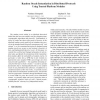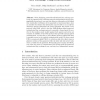216 search results - page 14 / 44 » Models and Proofs of Protocol Security: A Progress Report |
CCS
2008
ACM
13 years 8 months ago
2008
ACM
The Unified Model (UM) key agreement protocol is an efficient Diffie-Hellman scheme that has been included in many cryptographic standards, most recently in the NIST SP 80056A sta...
CCS
2008
ACM
13 years 8 months ago
2008
ACM
Multisignatures allow n signers to produce a short joint signature on a single message. Multisignatures were achieved in the plain model with a non-interactive protocol in groups ...
AINA
2007
IEEE
14 years 1 months ago
2007
IEEE
The random oracle model is an idealized theoretical model that has been successfully used for designing many cryptographic algorithms and protocols. Unfortunately, a series of res...
EUROCRYPT
2000
Springer
13 years 10 months ago
2000
Springer
Abstract. When designing password-authenticated key exchange protocols (as opposed to key exchange protocols authenticated using cryptographically secure keys), one must not allow ...
ACSD
2010
IEEE
13 years 4 months ago
2010
IEEE
We extend the partial order reduction algorithm of Clarke et al. [CJM00] to handle branching security protocols, such as optimistic fair exchange protocols. Applications of the pro...


